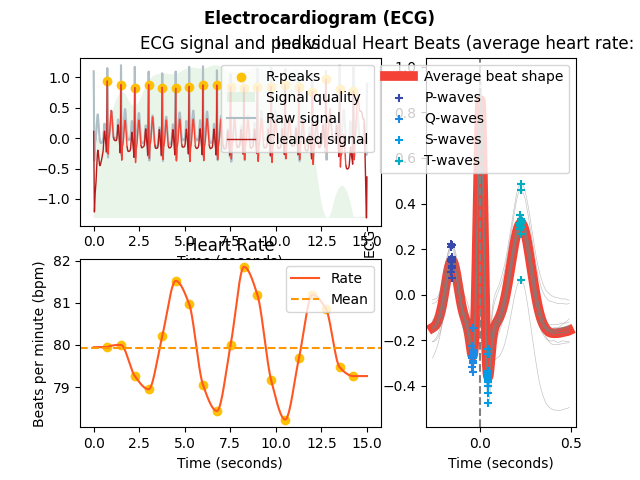心電図のパブリックデータ
- https://www.kaggle.com/datasets/shayanfazeli/heartbeat
- https://physionet.org/about/database/ https://physionet.org/content/adfecgdb/1.0.0/
- https://www.kaggle.com/datasets
- Published: 25 May 2020 PTB-XL, a large publicly available electrocardiography dataset Scientific Data volume 7, Article number: 154 (2020) https://www.nature.com/articles/s41597-020-0495-6
心電図の波形の起源
- 心電図の意味 http://ikagaku.jp/archives/14631
転移学習
- Classify Time Series Using Wavelet Analysis and Deep Learning This example shows how to classify human electrocardiogram (ECG) signals using the continuous wavelet transform (CWT) and a deep convolutional neural network (CNN). Training a deep CNN from scratch is computationally expensive and requires a large amount of training data. In various applications, a sufficient amount of training data is not available, and synthesizing new realistic training examples is not feasible. In these cases, leveraging existing neural networks that have been trained on large data sets for conceptually similar tasks is desirable. This leveraging of existing neural networks is called transfer learning. In this example we adapt two deep CNNs, GoogLeNet and SqueezeNet, pretrained for image recognition to classify ECG waveforms based on a time-frequency representation. GoogLeNet and SqueezeNet are deep CNNs originally designed to classify images in 1000 categories. We reuse the network architecture of the CNN to classify ECG signals based on images from the CWT of the time series data. The data used in this example are publicly available from PhysioNet. https://www.mathworks.com/help/wavelet/ug/classify-time-series-using-wavelet-analysis-and-deep-learning.html
医療データ解析
- Proceedings of Machine Learning Research 252:1–31, 2024 Machine Learning for Healthcare MedTsLLM: Leveraging LLMs for Multimodal Medical Time Series Analysis https://arxiv.org/pdf/2408.07773
データ
- medical-data-analysis Here are 20 public repositories matching this topic… https://github.com/topics/medical-data-analysis
ECG解析
心電図から異常を読み取って、心血管イベントの予測に活かすということは循環器内科医が実現したいことだと思います。そのような解析において、機械学習やAIがどう役立つでしょうか。
- Using AI to Detect ECG Abnormalities https://www.nyit.edu/news/articles/using-ai-to-detect-ecg-abnormalities/ 論文紹介記事
- Artificial intelligence-enhanced electrocardiography for the identification of a sex-related cardiovascular risk continuum: a retrospective cohort study The Lancet Digital Health ArticlesVolume 7, Issue 3e184-e194March 2025 https://www.thelancet.com/journals/landig/article/PIIS2589-7500(24)00270-X/fulltext 研究結果 AI-ECGは性別を高精度で識別した。BIDMCの外来患者において心電図が正常であった女性では、「性別不一致スコア」が高いほど、共変量で調整後の心血管死のリスクが有意に高かったが、男性ではそのような関連は見られなかった。UK Biobankコホートでも同様の傾向が見られた。 BIDMCコホートでは、「性別不一致スコア」が高い女性は将来の心不全や心筋梗塞を発症するリスクが高く、両コホートにおいて、男性的な心臓形態(左室質量および心腔容積の増加)や、男性的な非心臓的特徴(筋肉量の増加および体脂肪率の低下)も多く見られた。
- A comparison of artificial intelligence–enhanced electrocardiography approaches for the prediction of time to mortality using electrocardiogram images European Heart Journal – Digital Health, Volume 6, Issue 2, March 2025, Pages 180–189, https://doi.org/10.1093/ehjdh/ztae090 Published: 18 November 2024
- ECG signal feature extraction trends in methods and applications Anupreet Kaur Singh & Sridhar Krishnan BioMedical Engineering OnLine volume 22, Article number: 22 (2023) Published: 08 March 2023 https://biomedical-engineering-online.biomedcentral.com/articles/10.1186/s12938-023-01075-1
- Working with ECG — Heart Rate data, on Python Bartek Kulas Bartek Kulas Follow 9 min read · Feb 8, 2023 https://bartek-kulas.medium.com/working-with-ecg-heart-rate-data-on-python-7a45fa880d48
- How to analyze an ECG with Python Alejandro Ena Alejandro Ena Follow 4 min read · Nov 16, 2022 https://medium.com/@lalesena/how-to-analyze-ecgs-with-python-396e34ece937
- ECGxAI: Explainable AI for the electrocardiogram https://github.com/UMCUtrecht-ECGxAI/ecgxai
- Pre-Processing techniques and artificial intelligence algorithms for electrocardiogram (ECG) signals analysis: A comprehensive review Computers in Biology and Medicine Volume 170, March 2024, 107908 Computers in Biology and Medicine https://www.sciencedirect.com/science/article/pii/S0010482523013732
- ECG data classification and explainability with machine learning and deep learning algorithms Jaya Ojha Thesis submitted for the degree of Master in Applied Computer and Information Technology – ACIT (Data Science) 60 credits Department of Computer Science Faculty of Technology, Art and Design Oslo Metropolitan University — OsloMet Spring 2024 https://oda.oslomet.no/oda-xmlui/bitstream/handle/11250/3162970/no.oslomet%3Ainspera%3A232817044%3A126581247.pdf
- Harnessing 12-lead ECG and MRI data to personalise repolarisation profiles in cardiac digital twin models for enhanced virtual drug testing Medical Image Analysis Volume 100, February 2025, 103361 Camps et al. https://www.sciencedirect.com/science/article/pii/S136184152400286X
- Diagnosis of Atrial Fibrillation Using Machine Learning With Wearable Devices After Cardiac Surgery: Algorithm Development Study Daisuke Hiraoka1 Author Orcid Image ; Tomohiko Inui1 Author Orcid Image ; Eiryo Kawakami2, 3 Author Orcid Image ; 01.08.2022 in Vol 6, No 8 (2022): August https://formative.jmir.org/2022/8/e35396
- Real-life application of Artificial Intelligence for ECG analysis July 19, 2021 ブログ記事 https://cardiologs.com/blog/ai-systems-powered-by-deep-learning/
ECGと深層学習
- Deep Learning Applications in 12-lead Electrocardiogram and Echocardiogram. JMA J. 2025;8(1):102-112. Nakayama M, Yagi R, Goto S. https://www.jmaj.jp/detail.php?id=10.31662%2Fjmaj.2024-0195
- Prediction of incident atrial fibrillation using deep learning, clinical models, and polygenic scores European Heart Journal, Volume 45, Issue 46, 7 December 2024, Pages 4920–4934, https://doi.org/10.1093/eurheartj/ehae595
- Cardioattentionnet: advancing ECG beat characterization with a high-accuracy and portable deep learning model Front. Cardiovasc. Med., 06 January 2025 Sec. Cardiac Rhythmology Volume 11 – 2024 | https://doi.org/10.3389/fcvm.2024.1473482 この研究では、「CANet(キャネット)」という新しいコンピュータモデルを作りました。これは、心電図(しんでんず:心臓の動きを記録した波形のこと)を使って、不整脈(ふせいみゃく)という心臓のリズムの異常を早く見つけるためのものです。このモデルのすごいところは、小さくて軽くて、持ち運べる機械にも使えるように作られていることです。たとえば、スマホや腕時計みたいな機械にも入れられるってことです。中で使われている技術は、過去と未来のデータをよく見て判断するしくみ(BiLSTM)、大事なところを重点的に見るしくみ(Attention)、計算を速くして、必要な情報だけをうまく取り出すしくみ(軽量なフィルター)、これらを組み合わせることで、長い心電図データでも、ムダなくしっかり分析できるようにしています。そして、モデルは小さいのに、頭がいいというのがポイントです。「小さくてかしこい不整脈チェッカーを作ったよ!」という話。
- A systematic review and Meta-data analysis on the applications of Deep Learning in Electrocardiogram 07 July 2022 Volume 14, pages 9677–9750, (2023) https://link.springer.com/article/10.1007/s12652-022-03868-z
- Front Public Health. 2023 Nov 7;11:1273253. doi: 10.3389/fpubh.2023.1273253 Medical image analysis using deep learning algorithms Mengfang Li https://pmc.ncbi.nlm.nih.gov/articles/PMC10662291/
- ECG-Based Deep Learning and Clinical Risk Factors to Predict Atrial Fibrillation Circulation 8 November 2021 https://www.ahajournals.org/doi/10.1161/CIRCULATIONAHA.121.057480
異常の検出・予後予測
- Anomaly detection in healthcare data with Darts https://unit8.com/resources/anomaly-detection-in-healthcare-data-with-darts/
- Ensemble Post-hoc Explainable AI in Multivariate Time Series: Identifying Medical Features Driving Disease Prediction Jacqueline Michelle Metsch, Philip Hempel, Miriam Cindy Maurer, Nicolai Spicher, Anne-Christin Hauschild doi: https://doi.org/10.1101/2025.02.14.638219 Posted February 18, 2025.
- ECG data analysis and heart disease prediction using machine learning algorithms June 2019 DOI:10.1109/TENSYMP46218.2019.8971374 Conference: 2019 IEEE Region 10 Symposium (TENSYMP) Authors: Sushmita Roy Tithi https://www.researchgate.net/publication/338940370_ECG_data_analysis_and_heart_disease_prediction_using_machine_learning_algorithms
- https://quantumzeitgeist.com/british-heart-foundation-launches-ai-ecg-challenge-for-cardio-care/
データクリーニング
- EEG および ECG 信号クリーニングの概要 医療信号処理は人間の健康を理解する鍵です。EEGとECG信号は脳と心臓の機能に関する深い洞察を与えてくれます。しかし、これらの信号は有用な情報を明らかにするためにはクリーニングが必要です。https://editverse.com/ja/clean-filter-transform-complete-python-workflow-for-medical-signal-processing/
論文
- Clinically meaningful interpretability of an AI model for ECG classification Vadim Gliner, Idan Levy, Kenta Tsutsui, Moshe Rav Acha, Jorge Schliamser, Assaf Schuster & Yael Yaniv npj Digital Medicine volume 8, Article number: 109 (2025) 17 February 2025 https://www.nature.com/articles/s41746-025-01467-8
- Analyzing the performance of biomedical time-series segmentation with electrophysiology data Richard Redina, Jakub Hejc, Marina Filipenska & Zdenek Starek Scientific Reports volume 15, Article number: 11776 (2025) https://www.nature.com/articles/s41598-025-90533-y Published: 06 April 2025
- Machine learning for ECG diagnosis and risk stratification of occlusion myocardial infarction Nature Medicine volume 29, pages1804–1813 (2023) Published: 29 June 2023 https://www.nature.com/articles/s41591-023-02396-3
- Machine Learning-Based Clustering Using a 12-Lead Electrocardiogram in Patients With a Implantable Cardioverter Defibrillator to Identify Future Ventricular Arrhythmia Circulation Journal doi:10.1253/circj.CJ-24-0269 https://www.jstage.jst.go.jp/article/circj/advpub/0/advpub_CJ-24-0269/_pdf/-char/en
- Harnessing 12-lead ECG and MRI data to personalise repolarisation profiles in cardiac digital twin models for enhanced virtual drug testing Medical Image Analysis Volume 100, February 2025, 103361 https://www.sciencedirect.com/science/article/pii/S136184152400286X
PythonによるECG解析モジュール
- https://neuropsychology.github.io/NeuroKit/functions/ecg.html

時系列データ解析
- Platform for Analysis and Labeling of Medical Time Series Sensors 2020, 20(24), 7302; https://doi.org/10.3390/s20247302
- Guide to Time-Series Analysis in Python https://www.tigerdata.com/blog/how-to-work-with-time-series-in-python#object-objectwhy-use-python-for-time-series-data-analysis